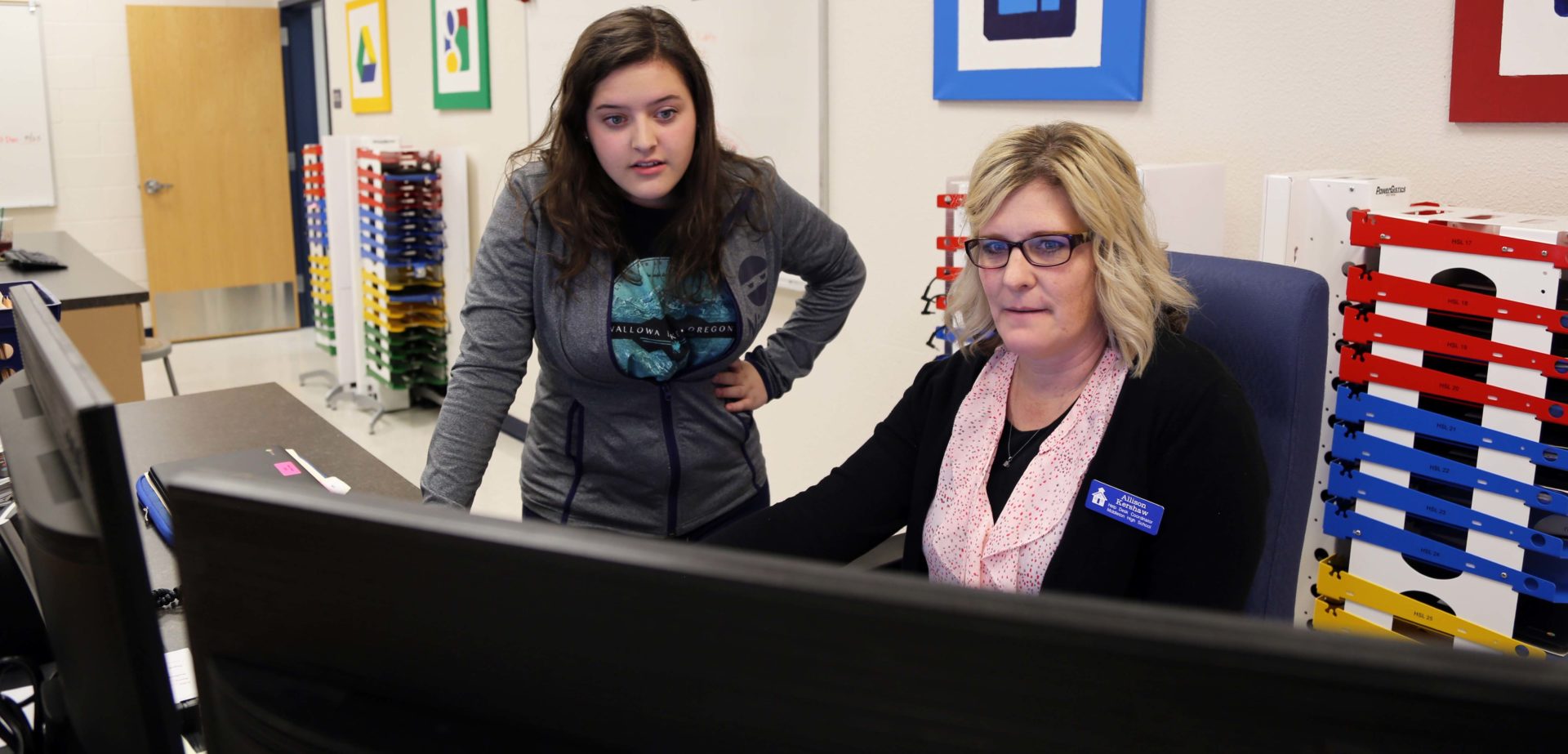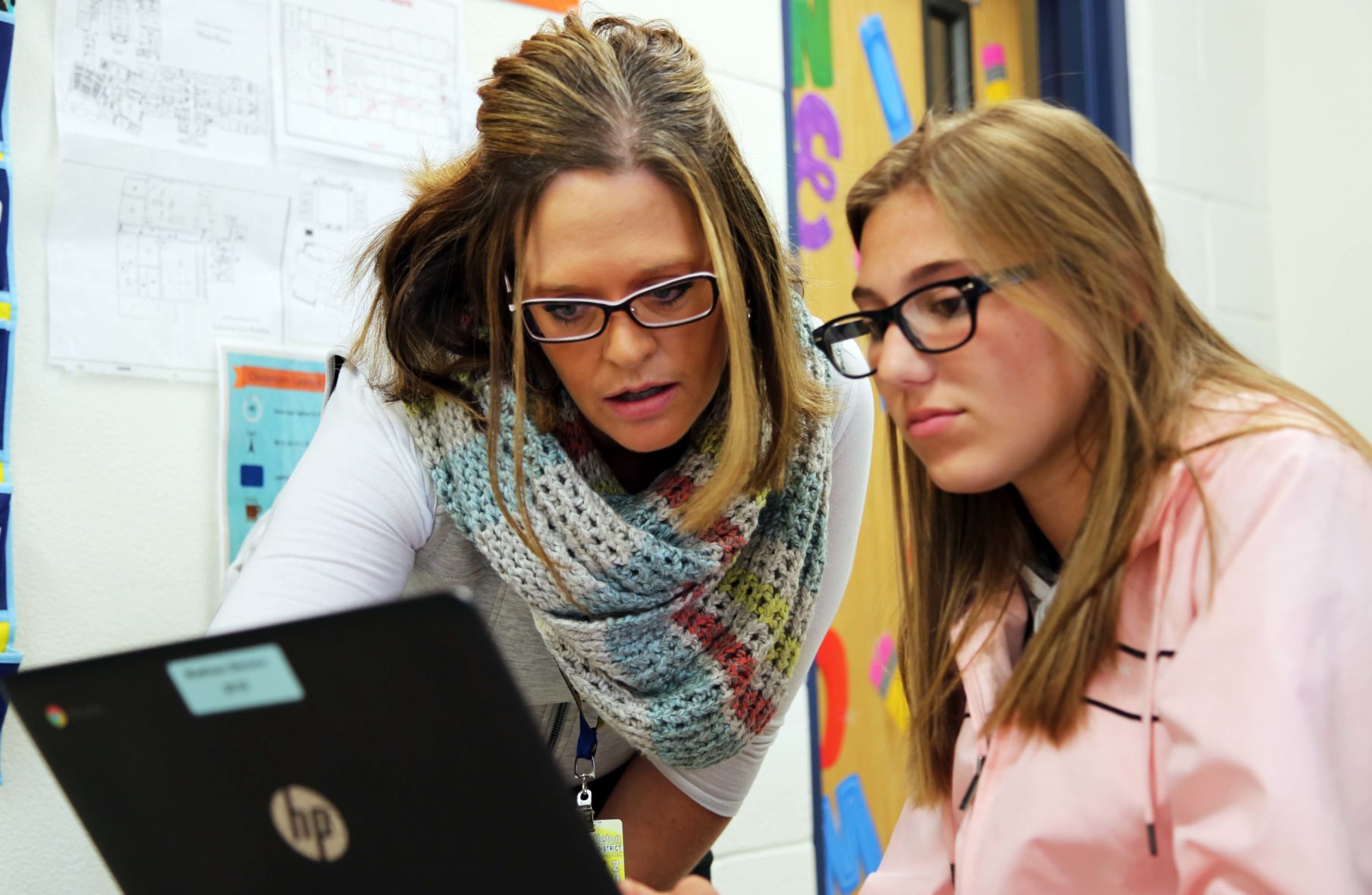In 2013, when Middleton High School equipped all of its students with laptops, Sharlea Watkins wanted her Middleton Middle School students to have similar equipment — and similar opportunities.
It took four years and some lobbying, but the laptops arrived in September.
For Watkins, the middle school’s vice principal, the goals are twofold: prepare middle schoolers for ninth grade at a computer-driven high school; and prepare students for life beyond a Canyon County town that is part farm country, part growing bedroom community.
“It’s where our world is,” she said. “I wanted to keep our kids current.”
1:1, times two
In classroom technology jargon, both the high school and the middle school are “1:1” schools. One student, one computing device. For some 2,500 sixth- through 12th-graders.
The 1:1 programs mean different things for different students.
For some students, a school-issued laptop opens new opportunities. About 46 percent of Middleton’s students qualify for free or reduced-price lunch; a 1:1 program puts them on equal footing. “It really makes them feel like they’re included in the vision,” said Mike Cozakos, Middleton’s IT director.
For 13 high school students and 18 middle school students, the 1:1 programs provide them a taste of life in IT support. They spend a class period as tech “ninjas,” helping classmates revive dead batteries and navigate through computer settings. Eighth-grader Logan Reed says he likes technology and helping people, and the ninja experience has him thinking about a career in computers. “This is a good start.”
The 1:1 initiative allows students to easily complete video reports or senior portfolios. But district Superintendent Josh Middleton wants to see more.
“There’s got to be evidence that it makes sense for student achievement,” he said. “Otherwise, it’s just a device.”
Beyond the pilot
Middleton’s tech boom grew, at least indirectly, from political controversy.
In November 2012, voters overwhelmingly rejected then-state superintendent Tom Luna’s proposed K-12 overhauls, including an unpopular proposal to provide every high school student a laptop. In 2013, Luna responded with a $3 million-a-year technology pilot grant program.
Eighty-one schools applied for grants. Middleton High School was one of only 11 schools to make the cut. The $427,872.40 enabled Middleton to buy laptops for every student.
Pilot money allows a project to get off the ground — but it doesn’t provide sustainable funding. That left Middleton with a dilemma. Teachers and trustees didn’t want to give up on the 1:1 program. But the 2013-era laptops were too expensive to maintain, Cozakos said.
For the second-generation program, Middleton is moving to Chromebooks, a smaller version of a laptop, and a lease arrangement. The district hopes to get five years of use from the Chromebooks, Cozakos said.
It will cost about $500,000 to lease 2,400 devices for high school and middle school students, with the money coming from a state budget line item earmarked for classroom technology. That’s a growing line item, as educators across Idaho look to incorporate technology into their schools. This year’s line item was $28.1 million; for 2018-19, state superintendent Sherri Ybarra has proposed an $8.6 million increase.
A seamless rollout
It sounds like a straight line. Put brand-new computers into the hands of hundreds of middle school students. What could possibly go wrong?
Not much, actually.
“I could never have pictured something going so smoothly in my life,” Watkins said.
Enthusiasm for the 1:1 initiative translated into big crowds for school orientation sessions. Parents seem to be on board. Only a couple of parents have opted their kids out of the program. With few exceptions, parents have signed up their kids to take their computers home on nights and weekends.
The students also seem to be taking ownership. Repair calls have been rare — less than the district expected, and similar to what the district sees at the high school. Cozakos gives the credit to the middle school students.
“They didn’t take it as much for granted as the high school kids,” he said.
Superintendent Middleton says Chromebooks are no substitute for great teachers and good training. But he likes what he’s seen with the rollout so far. “Every single class has utilized their devices.”
Two generations of ninjas
Melissa McDonald found her way into the ninja program by accident. She was interested in technology; as a ninth-grader, she worked on the sound crew for the school production of “Beauty and the Beast.” When she had an open period in 10th grade, she applied for the ninja program.

She was accepted, and she got hooked. She’s seen everything from minor repairs to one laptop that was run over by a school bus. She likes the work environment of a help desk, and considers her fellow ninjas a “little family.”
After sophomore year, she landed a summer job in the district’s technology office. Now she’s a second-year ninja, with plans to study IT in college.
“I just had one decision that really just changed the course of the rest of my life,” she said.
The ninjas play an important role in keeping the 1:1 program going, Cozakos said. When a student hits a minor glitch — such as a screen display rotated into a sideways setting — the ninjas are the first responders. At the end of the day, they check in Chromebooks that students aren’t taking home, and they check them back out the next school day.
It’s not lost on anyone that the ninja experience can shape career goals. Several members of the ninja Class of 2017 are studying computer science in college. Their headshots line one wall in the ninja workspace. “This is the ninja hall of fame,” said Allison Kershaw, the high school’s help desk coordinator.
When Middleton Middle School launched its 1:1 program, the school also created a ninja team, open to seventh- and eighth-graders.
For seventh-grader Emma Lanegan, it came down to a choice between a period on the help desk and a period in Spanish. She chose the help desk. She comes from an IT family — her mother coordinates the middle school help desk — and she’s starting to think about her own career.
“I’d definitely love to do this throughout high school,” she said.
‘We have a ways to go’
At Middleton High School, Kelly Cooke’s senior advancement class students use their Chromebooks for a variety of assignments — from the often-dreaded senior project to a scholarship application exercise. One recent morning, students worked to find three scholarships that meet their post-graduation goals — and apply for one.

The online process allows students to find more potential scholarships, and provides students with more immediate feedback on their applications. “I think this is the right tool for this job,” she said.
This job was the driving force behind the 2013 tech pilot: Middleton wanted to better prepare their high school graduates to stay in school. This has proven to be a stubborn challenge. In 2016, only 42 percent of Middleton’s graduates immediately enrolled in college, trailing the state’s lackluster go-on rate of 48 percent.
Superintendent Middleton says a successful 1:1 program will help the district improve its test scores and go-on rates.
But it might be too early to gauge the results. While the district used a pilot grant to invest in technology, it didn’t invest in curriculum. During the recession, many districts put off curriculum upgrades, Middleton said. And that affects student performance.
“We have a ways to go,” he said.
